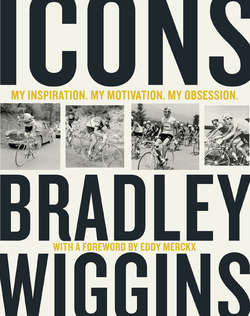Читать книгу Icons: My Inspiration. My Motivation. My Obsession. - Bradley Wiggins, Bradley Wiggins - Страница 7
ОглавлениеINTRODUCTION
CYCLING SEEMS TO ATTRACT A LOT OF COLLECTORS, probably because it’s always been so important historically and culturally. You could say it’s just a sport, but the bike itself still plays a big role in the way human civilisations think and act. You only have to look at places like Holland and China to see this, and to understand that, long after fossil-fuel cars have disappeared, the humble bike will still be around. I genuinely don’t think there’s any one single invention that has been healthier for the human mind and body, so while it is ‘just’ a sport, for many people it’s also a way of life and of living.
Bike racing is unique among mainstream sports because its development was totally organic. It didn’t have to be ‘invented’ like the others, because Europeans have been learning to cycle for well over 100 years. Going fast on a pushbike is the most natural thing in the world, and organised racing is just an extension of that.
As a professional sport it has two special characteristics. The first is that it’s free to watch; the second, that it goes to its public and not vice versa. What I mean by this is that there are no filters – the riders are literally within touching distance, and the public are intrinsic to the spectacle. It’s much easier to watch cycling on TV, and actually being there means you’re only going to see a tiny fraction of the action. The feeling a bike race generates, however, is electric, and I think that’s one of the reasons people stand by the roadside for hours waiting for what often amounts to a few moments. The key is its sheer intimacy, and that’s why the sport is so closely linked to its fans’ identity. Of course, there are millions of hobby cyclists, but there are also people like me, for whom it’s all-consuming.
Thinking I’m Joey McLoughlin at Herne Hill in 1988.
I think all of the above – and certainly some complex anthropological stuff – explains the collecting thing. People go nuts for bidons, but also musettes, caps, race numbers, race direction signs and accreditation paraphernalia. There are guys with massive collections of postcards, cigarette cards, autographs, race books, photographs, miniatures, badges and magazines. There are also people who collect specific brands, especially exotic Italian ones like Campagnolo, Bianchi and Colnago. There are guys who collect stuff from specific races, typically the Giro and the Tour, and of course there are collectors of the bikes themselves. There are loads of personal museums, and I know of a chap in Italy who has over 300 perfectly restored professional racing cycles. He keeps them in a massive house he rents halfway up a mountain, and it has more security than Fort Knox. That guy also has three ex-wives, but such is life …
Eastway 1995, in the exact spot on which the finish line of the velodrome now sits.
For people like me, however, it’s all about the jerseys.
Football and cricket teams get a trophy if they win, or an urn full of ashes. In track and field they get a medal. In golf the winner of the Masters gets a green jacket, and in World Series baseball the champions get a ring. I’m sure they’re fantastic things, but they’re basically inanimate. They’re not used in competition, and there’s nothing used or worn in any of these sports that distinguishes the champions from the mere mortals. Diego Maradona and Michael Jordan had a number on their backs, but essentially they wore the same kit as the others, as did individual sporting greats such as Borg, Bolt and Ali.
Like all great sportsmen, champion cyclists come and go. So do their sponsors, but their jerseys remain. Over the years they accumulate value, because through them we learn the history of our sport and, as cycling people, of ourselves – they’re also a mirror of the times, on our habits and our culture. First, the sponsors were the bike manufacturers and then, after the war, companies that made leisure items and consumer goods. It started with toothpaste, because as we became wealthier dental hygiene became more affordable. Next came things like aperitifs, and status symbols such as domestic appliances. They were followed by fitted kitchens, televisions, colour televisions, ice cream for the kids. Then cars, travel agents, video recorders, telecoms … As you work through the collection, it becomes apparent that the evolution of the brand logos is of as much interest and importance as that of the shirts themselves. Cycling jerseys not only tell us the story of cycling and of cyclists, but also, if we look closely, of the continent.
Then, of course, there are the leaders’ jerseys and champion’s jersey. They are the cycling icons, and there’s a small army of people like me who collect them. Of course, what we’re really collecting is proximity. Through the jerseys we feel closer to the champions who wore them, because they’re the people who wrote the history of the thing we love.
This book constitutes a thank-you note to 21 of them and, overwhelmingly, a love letter to the sport of cycling.
I hope you enjoy it.
Me with 1980 and 1986 world champion Tony Doyle. Great Flintstones’ shorts!
